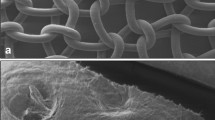Abstract.
Two types of monofilament polypropylene meshes of markedly different construction, configuration and pore size were compared and used to repair full-thickness muscle defects in the abdominal wall of 22 mongrel dogs to assess their biocompatibility with host tissues. The defects were repaired with Prolene (Ethicon) woven mesh (pore size=164×96 µm) and with an experimental, extruded mesh called T mesh (pore size=3 mm×4 mm). On the 30th postoperative day, the animals were sacrificed, and the segments of the abdominal wall containing the implanted meshes were excised. Although the Prolene mesh had greater tensile strength before implantation, 30 days after implantation, the T mesh showed similar tensile strength to Prolene mesh. The collagen densitometry showed a significant increase of total and mature collagen type I deposition in the T mesh. This suggests that the increased mature collagen type I deposition significantly increases the tensile strength of the reinforced mesh tissue and that the larger pore in the T mesh contributed to this finding by allowing increasing fibber orientation within the pores as a result of in vivo tension.
Similar content being viewed by others
Author information
Authors and Affiliations
Additional information
Electronic Publication
Rights and permissions
About this article
Cite this article
Greca, .F., Paula, .J., Biondo-Simões, .M. et al. The influence of differing pore sizes on the biocompatibility of two polypropylene meshes in the repair of abdominal defects. 5, 59–64 (2001). https://doi.org/10.1007/s100290100001
Received:
Accepted:
Issue Date:
DOI: https://doi.org/10.1007/s100290100001




